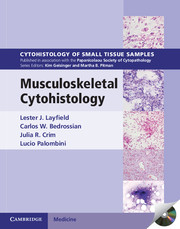Book contents
- Frontmatter
- Contents
- 1 Principles and practice for biopsy diagnosis and management of musculoskeletal lesions
- 2 Ancillary techniques useful in the evaluation and diagnosis of bone and soft tissue neoplasms
- 3 Spindle cell tumors of bone and soft tissue in infants and children
- 4 Spindle cell tumors of the musculoskeletal system characteristically occurring in adults
- 5 Giant cell tumors of the musculoskeletal system
- 6 Myxoid lesions of bone and soft tissue
- 7 Lipomatous tumors
- 8 Vascular tumors of bone and soft tissue
- 9 Pleomorphic sarcomas of bone and soft tissue
- 10 Osseous tumors of bone and soft tissue
- 11 Cartilaginous neoplasms of bone and soft tissue
- 12 Small round cell neoplasms of bone and soft tissue
- 13 Epithelioid and polygonal cell tumors of bone and soft tissue
- 14 Cystic lesions of bone and soft tissue
- Index
12 - Small round cell neoplasms of bone and soft tissue
Published online by Cambridge University Press: 05 September 2013
- Frontmatter
- Contents
- 1 Principles and practice for biopsy diagnosis and management of musculoskeletal lesions
- 2 Ancillary techniques useful in the evaluation and diagnosis of bone and soft tissue neoplasms
- 3 Spindle cell tumors of bone and soft tissue in infants and children
- 4 Spindle cell tumors of the musculoskeletal system characteristically occurring in adults
- 5 Giant cell tumors of the musculoskeletal system
- 6 Myxoid lesions of bone and soft tissue
- 7 Lipomatous tumors
- 8 Vascular tumors of bone and soft tissue
- 9 Pleomorphic sarcomas of bone and soft tissue
- 10 Osseous tumors of bone and soft tissue
- 11 Cartilaginous neoplasms of bone and soft tissue
- 12 Small round cell neoplasms of bone and soft tissue
- 13 Epithelioid and polygonal cell tumors of bone and soft tissue
- 14 Cystic lesions of bone and soft tissue
- Index
Summary
INTRODUCTION
Small round cell malignancies represent a diagnostic category of primitive neoplasms occurring predominately in infants and children. These neoplasms show limited degrees of differentiation towards mature tissues. While many occur in mesenchymal organs, small round cell tumors are recognized in the kidney (Wilms’tumor), adrenal glands (neuroblastoma), and the brain (medulloblastoma). While the majority of small round cell malignancies arising in the mesenchymal tissues occur in children, small round cell malignancies do occur in adults where they are represented by a variety of lymphomas and small cell carcinomas. Small cell carcinomas frequently have varying degrees of neuroendocrine differentiation and occur at a variety of sites including the lung, bladder, and prostate. Small cell carcinomas may metastasize to bone and soft tissue.
Traditionally, small round cell malignancies have been a source of significant diagnostic challenges as separation on a purely morphologic basis is difficult. While many small round cell malignancies show varying degrees of differentiation towards mature tissues (rosettes in neuroblastomas, tubules in Wilms’ tumors, and cross striations in rhabdomyosarcomas), the majority of cells disclose only a primitive cell morphology. Although electron microscopy is diagnostically useful, immunohistochemistry has enhanced the separation of these lesions into meaningful therapeutic categories. Hence, rhabdomyosarcomas frequently demonstrate immunohistochemical positivity for muscle markers including desmin, caldesmin, muscle actins and myogenin, leukemias and lymphomas demonstrate hematopoietic differentiation markers, and primitive neuroectodermal tumors may express neural markers in at least a fraction of the cells. More recently, molecular diagnostics has demonstrated a number of clinically useful translocations greatly improving our accuracy in the diagnosis of these neoplasms.
- Type
- Chapter
- Information
- Musculoskeletal Cytohistology , pp. 247 - 274Publisher: Cambridge University PressPrint publication year: 2000

